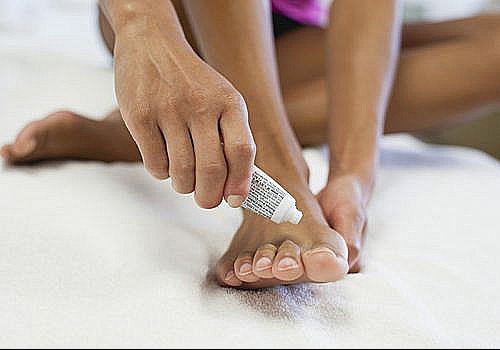Lennard Wilson, 64, noticed his feet began to itch and burn. He also noticed cracked skin on the soles of his feet and in between his toes. At first, the Brooklyn, NY resident ignored what was going on with his feet and thought using lotion would take care of his problem. After much urging from his wife, Valessa, Lennard went to a dermatologist. The diagnosis, athlete’s foot.
Athlete’s foot or tinea pedis is a common infection that usually starts between the toes. It is estimated that 3% to 15% of the population is affected. Men and older adults are more likely to get it. The foot condition typically begins as a scaly rash and can become itchy and painful as it progresses. Some types of athlete’s foot feature blisters or ulcers. Athlete’s foot is contagious and closely related to other fungal infections such as ringworm and jock itch.
The fungus can affect one or both feet and may spread to the soles of the feet and the toenails. It can be spread to other parts of the body as well, particularly the groin and underarms, by those who scratch the infection and then touch themselves elsewhere.
The foot infection is even more of a concern for African Americans with diabetes. Athlete’s foot in diabetics can lead to a fungal infection of the toenails that may cause the skin on your feet to crack, which can lead to a serious infection. If you have diabetes, see your doctor if you suspect you have athlete’s foot, especially if you notice any signs of a possible secondary bacterial infection such as excessive redness, swelling, drainage, or fever. Since diabetes is a systemic condition that can affect the feet, it is best to stay on top of any changes you see with a physician.
Causes
The fungus enters the skin through small cracks or wounds, and infect the top layer. Fungal skin infections need moisture and warmth to spread. Our feet offer a perfect environment for them, because we wear shoes for most of the day and so our feet are often warm and moist, humid conditions that favor the organisms’ growth. The infection can be spread by being in contact with someone who has it, or you can pick it up from a contaminated surface like floors, shoes, or even towels.
Risk Factors
- Being male
- Being older
- Wearing damp socks or tight footwear
- Sharing mats, carpeting, shoes, a bed with an infected person
- Walking barefoot in public places
- Genetic predisposition
- Allergies and eczema
- Vascular problem in the legs as the result of diabetes or narrowed blood vessels
- Wearing sturdy work shoes, safety boots or rubber boots for long stretches
Prevention
- Thoroughly dry your feet after a shower/bath or swimming
- Wear shoes that let your feet breathe
- Change your socks daily and if your feet are sweaty, more often
- Don’t wear the same shoes for days on end
- Don’t walk barefoot in public places
- Don’t share your shoes, socks or towels with anyone
- Let your feet breathe as often as possible
- Consider using an antifungal powder on your feet daily
- Don’t scratch the affected area
Treatment
Athlete’s foot can be treated effectively with topical antifungal treatments such as creams, powders, sprays, gels and often without a prescription. Some folks resort to using home-based remedies like tea tree oil that contains antiseptic and fungicidal properties, but there is no scientific proof this cures the problem.
If OTC preparations do not cure the fungal infection, then your doctor might have to prescribe a medicine that typically comes in a pill form to do the trick.











